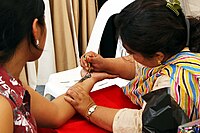Mehndi


Mehndi (Hindi: मेहँदी, Template:Lang-ur) is the application of henna as a temporary form of skin decoration in Pakistan and India, as well as by expatriate communities from these areas. Mehndi decorations became fashionable in the West in the late 1990s, where they are sometimes called henna tattoos. Henna is typically applied during special occasions like weddings and festivals. It is usually drawn on the palms and feet, where the color will be darkest because the skin contains higher levels of keratin which binds temporarily to lawsone, the colorant of henna. Henna was originally used as a form of decoration mainly for brides.
The term henna tattoo is inaccurate, because tattoos are defined as permanent surgical insertion of pigments underneath the skin, as opposed to pigments resting on the surface as is the case with mehndi.
Likely due to the desire for a "tattoo-black" appearance, many people have started adding the synthetic dye p-Phenylenediamine (PPD) to henna to give it a black colour. PPD is extremely harmful to the skin and can cause severe allergic reactions resulting in permanent injury or death.[1] [2] Alata (Mahur) is a flower-based dye used to paint the feet of the brides in some regions of India. It is still used in Bengal.
Process

Henna paste is usually applied on the skin using a plastic cone or a paint brush, but sometimes a small metal-tipped jacquard bottle used for silk painting (a jac bottle) is used. The painted area is then wrapped with tissue, plastic, or medical tape to lock in body heat, creating a more intense colour on the skin. The wrap is worn overnight and then removed. The final colour is reddish brown and can last anywhere from two weeks to several months depending on the type of the paste.
Tradition

There is evidence that mehndi as a ceremonial art form originated in ancient India. Intricate patterns of mehndi are typically applied to brides before wedding ceremonies see here. The bridegroom is also painted in some parts of India, Pakistan, Nepal, Bangladesh and Sudan. In Rajasthan (north-west India), the grooms are given designs that are often as elaborate as those for brides. In Assam, apart from marriage, it is broadly used by unmarried women during Rongali bihu (there’s no restrictions to the married ones).
The use of henna and mehndi by Muhammad ensured its place in history and its popularity and acceptance among the Muslim people. In Arabic speaking countries such as Morocco, and some other countries in central Asia, it is done for any special occasion. It is done during the seventh month of pregnancy, after having the baby, weddings, engagements, family get-togethers, diwali, as well as on other occasions.
Mehndi celebration
Weddings in India, Pakistan and Bangladesh are considered to be a sacred and sanctified ceremony. They can often be long ritualistic and elaborate affairs with lots of pre-wedding, wedding and post wedding ceremonies. The occasion of Mehndi ceremony is often one of the most important pre-wedding rituals especially for the bride. It is a fun filled ritual, which is celebrated mainly by the bride's family. Different regions of the country celebrate the ritual in a different way according to their own marriage customs, rituals, and culture. Mehndi ceremonies take place outside the Indian sub-continent amongst the Asian community and places like Birmingham in the UK are such known hotspots for lavish Mehndi celebrations.
The ceremony is mainly held at the bride's house or at a banquet hall on the eve of the marriage ceremony or few days before the marriage. Generally the bride and groom attend the event together and on the occasion a professional henna artist or a relative applies mehndi to the bride’s hands and feet the designs are very intricate. Often hidden within the mehndi pattern the name or initials of the groom are applied. The event generally has a celebratory festival feel to it with the women dancing and singing traditional songs and the girls wearing vivid colours such as hot pink and yellow, often if the bride to be wishes to tease her future groom she will make him wear purple. The groom usually wears jutti instead of western footwear.
Gallery
-
Sudanese woman's hands with mehndi
-
Indian bride's hands with mehndi
See also
References
- ^ Warnings: PPD Black Henna: http://www.hennapage.com/henna/ppd/index.html
- ^ Hand Drawn Mehndi Designs: http://www.hennamehndi.in/


